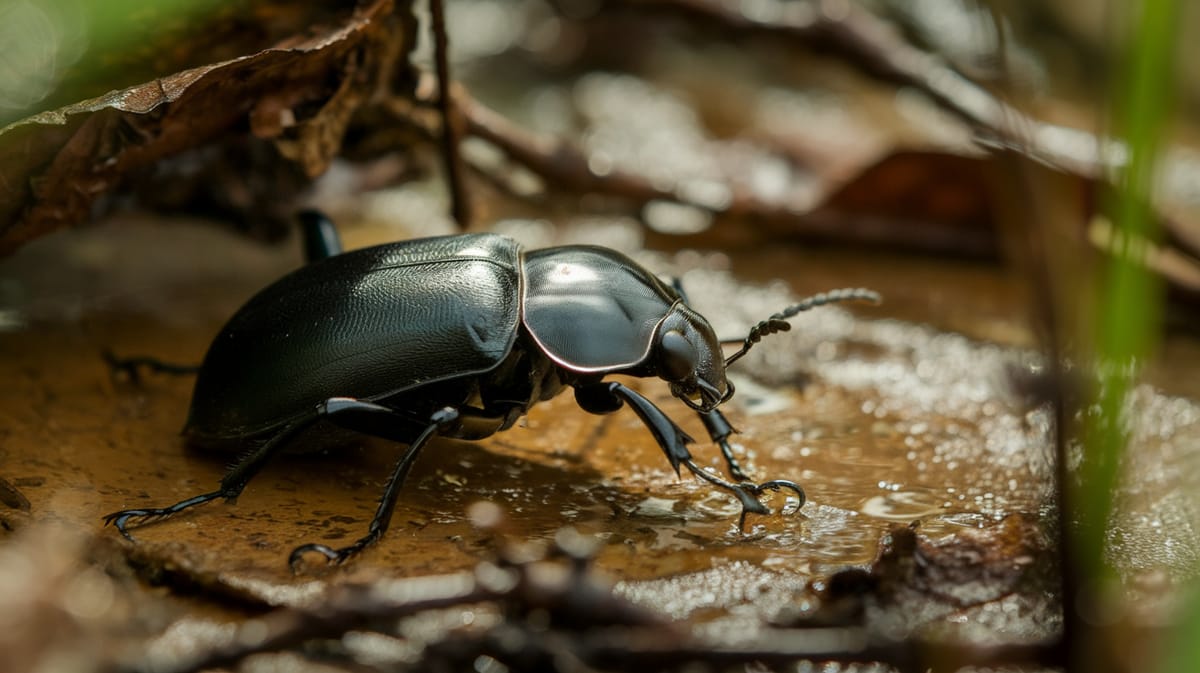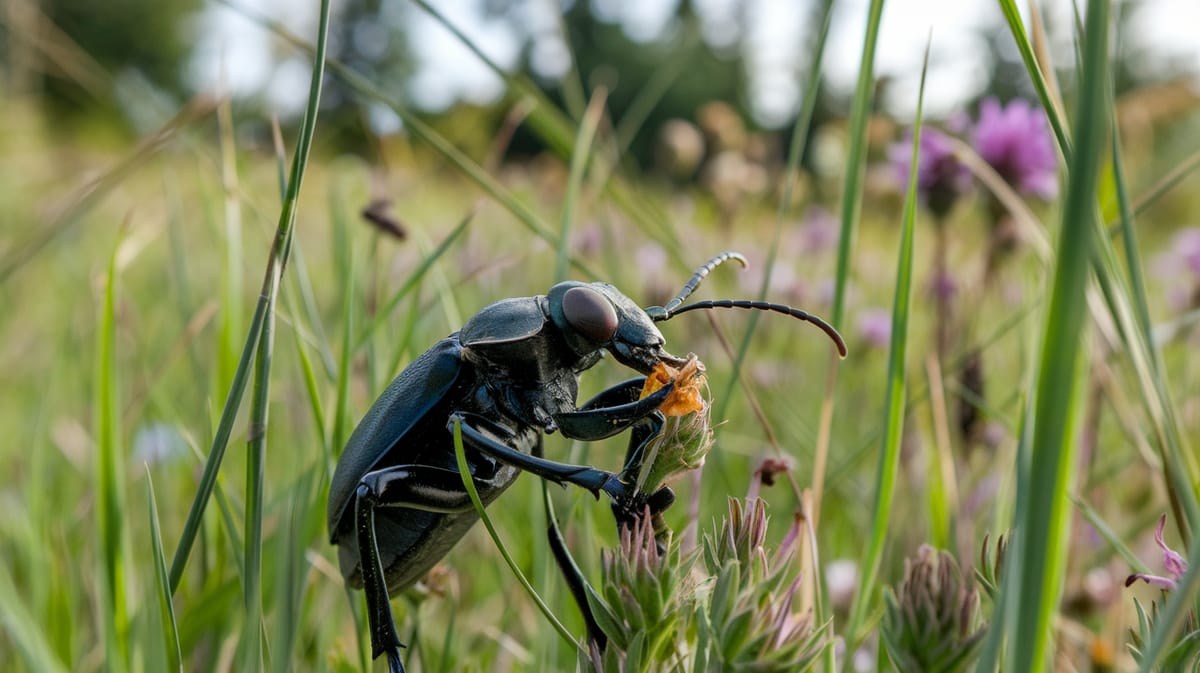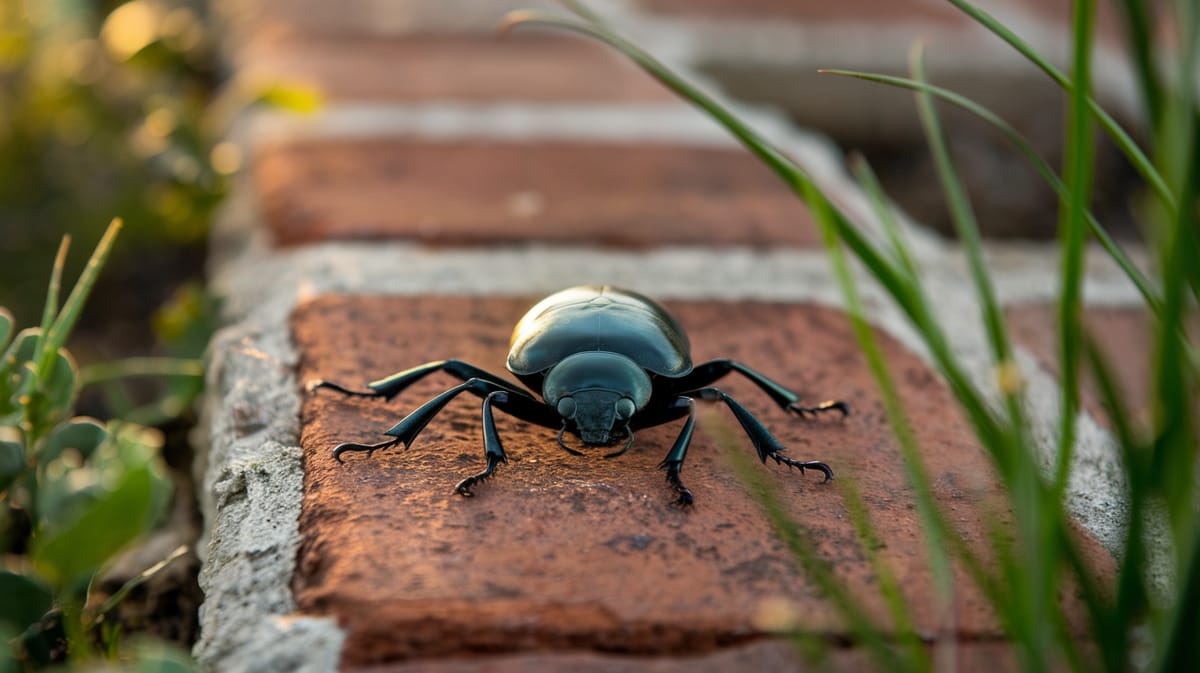Common Black Ground Beetle
Sleek and relentless, the Common Black Ground Beetle patrols gardens, devouring pests and maintaining ecological balance. Its nocturnal hunting habits make it a vital ally for farmers.

Key Insights at a Glance
Did You Know?
Taxonomy & Classification
Common Black Ground Beetles are agile nocturnal hunters, with powerful mandibles and keen senses, reflecting their lineage’s adaptation to life in diverse terrestrial ecosystems. Let's understand the evolutionary journey and classification of these remarkable predators, decomposers.
Species Diversity
Pterostichus includes over 1,100 species globally, showcasing its adaptability to various climates and terrains.
Resilient Evolution
Originating in the Mesozoic era, these beetles have thrived through significant climatic shifts, demonstrating impressive evolutionary resilience.
Lifecycle and Growth
A remarkable journey of transformation from Egg to Adult.
Egg
Eggs are laid in moist soil, offering a secure start for developing embryos within protective shells.
Larva
Larvae are voracious predators, consuming small insects and growing rapidly in size.
Pupa
In a protective cocoon, the larva transforms, reorganizing its structure to emerge as an adult beetle.
Adult
Adults emerge ready to hunt and reproduce, playing a role in controlling soil pest populations.
Dietary Habits
A nocturnal hunter with keen senses, it primarily feeds on insects, earthworms, and occasionally small vertebrates when the opportunity arises.
| DIET TYPE | DESCRIPTION |
|---|---|
| Primary Diet | Primarily consumes caterpillars, beetle larvae, and slugs, using its powerful mandibles for efficient predation. |
| Secondary Diet | Feeds on earthworms and small snails, supplementing its diet with these when insect prey is scarce. |
| Occasional | Occasionally consumes small amphibians or carrion, displaying adaptability in its feeding habits during food shortages. |

Behaviour and Adaptations
Discover the fascinating adaptations that equip the Common Black Ground Beetle for survival and efficiency.
Nocturnal Foraging
Active at night, it efficiently hunts for prey in darkness.
Defensive Secretions
Emits a chemical spray to deter predators and ensure safety.
Speedy Movement
Capable of quick bursts of speed to escape threats or chase prey.
Ecosystem Impact
Ecosystem Impact
Natural Pest Control
Feeds on pests like slugs and caterpillars, reducing their populations naturally.
Soil Aeration
Enhances soil structure by burrowing, promoting oxygenation and nutrient cycling.
Food Chain Component
Serves as prey for birds and small mammals, supporting biodiversity.
Conservation Challenges
Understanding and addressing the major threats to Common Black Ground Beetle populations.
Habitat Loss
Urban development and agriculture reduce beetle habitats, impacting their survival.
Pesticide Use
Chemical pesticides disrupt beetle health and ecosystems.
Climate Change
Altered weather patterns affect beetle life cycles and distribution.
Frequently Asked Questions
How long do Common Black Ground Beetle live?
Common Black Ground Beetles typically live for about one to four years, depending on environmental conditions and food availability. Their lifespan can vary based on factors such as climate, habitat, and predator presence.
What do Common Black Ground Beetle eat?
These beetles primarily feed on other small insects, larvae, and organic matter. They are beneficial in gardens as they help control pest populations by preying on slugs, caterpillars, and other garden pests.
Are Common Black Ground Beetle poisonous?
Common Black Ground Beetles are not poisonous to humans or pets. They are generally harmless and do not pose any significant health risks. They are beneficial for controlling pest populations rather than posing any threat.
Are Common Black Ground Beetle endangered?
Common Black Ground Beetles are not considered endangered. They are widespread and abundant in various habitats, including gardens, forests, and fields. Their populations are stable, and they are not currently at risk of extinction.
What do Common Black Ground Beetle symbolize?
These beetles often symbolize resilience, adaptability, and persistence. They are known for their ability to thrive in different environments and play a crucial role in maintaining ecological balance by controlling pest populations.
Do Common Black Ground Beetle bite?
Common Black Ground Beetles do not bite humans. They may use their mandibles for defense if threatened, but they are not aggressive and rarely pose any risk to people.
What color are Common Black Ground Beetle?
Common Black Ground Beetles are typically black in color, although they may sometimes have a slight metallic sheen on their exoskeleton. Their dark coloration helps them blend into their surroundings and avoid predators.
Does a Common Black Ground Beetle have wings?
Yes, Common Black Ground Beetles have wings. They possess a pair of hardened forewings called elytra that protect their flight wings. While they can fly, they mostly prefer to walk or run quickly on the ground.
What does a Common Black Ground Beetle look like?
These beetles are medium-sized, measuring about 1-2 centimeters in length. They have a smooth, oval-shaped body, long legs, and prominent mandibles. Their antennae are relatively long, and they have a shiny black exoskeleton.
Is a Common Black Ground Beetle an insect?
Yes, the Common Black Ground Beetle is an insect. It belongs to the family Carabidae and is classified within the order Coleoptera, which includes all beetles. As insects, they have six legs, a segmented body, and an exoskeleton.
Related Insects
Discover insects with similar characteristics to Common Black Ground Beetle - including shared habitats, diets, and taxonomic classifications
Share this profile
Help others discover Common Black Ground Beetle
